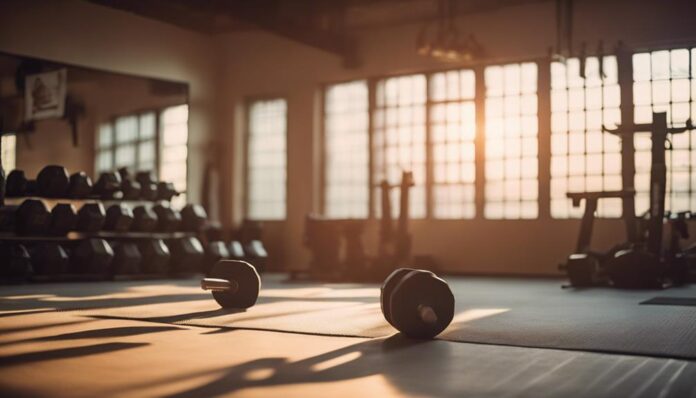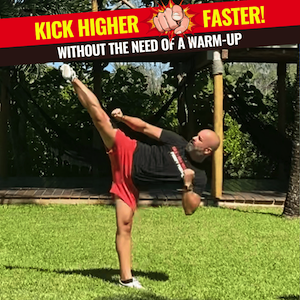As an older martial artist, you're likely experiencing a decline in physical capabilities, including chronic pain, flexibility loss, and increased physical limitations. Conditioning exercises are essential to address these challenges, targeting muscle strength, flexibility, and balance to prevent injuries. Regular training, at least twice a week for 11 weeks, can improve strength by 9.3% to 34% and balance by 20.5%. Conditioning also reduces chronic pain by alleviating support muscle stress and enhancing joint stability. By prioritizing conditioning, you'll be better equipped to manage age-related physical changes and maintain a safe and effective practice – and that's just the beginning.
Key Points
- Conditioning exercises improve strength, flexibility, and balance to prevent injuries in older martial artists.
- Strength training enhances joint stability and alleviates chronic pain by reducing muscle stress.
- Regular flexibility training can improve range of motion by up to 316.7% and mitigate injury risks.
- Conditioning helps manage chronic pain and maintain functional fitness and quality of life in older adults.
- Low-impact exercises and prioritized recovery methods enable sustainable martial arts practices for older martial artists.
Conditioning Exercises for Injury Prevention
As an older martial artist, you're likely no stranger to the physical demands of your craft, and a well-structured conditioning program is vital to mitigating the risk of injuries.
Conditioning training specifically targets muscle strength, flexibility, and balance, which are important for injury prevention and enhancing overall functional fitness.
By incorporating low-impact activities such as resistance training and flexibility exercises into your conditioning program, you can achieve significant strength gains, ranging from 9.3% to 34%, as evidenced in studies involving older adults in martial arts.
Regular balance exercises can also result in substantial improvements, increasing balance capability by approximately 20.5%, which reduces the risk of falls among older practitioners.
A well-rounded conditioning program can also alleviate chronic pain and joint issues by strengthening support muscles and improving joint stability through targeted exercises.
To achieve meaningful improvements in overall health and injury prevention, it's recommended to engage in conditioning training at least twice weekly for at least eleven weeks.
Age-Related Physical Changes in Martial Arts
As you age, you'll likely experience a decline in physical capabilities, including increased physical limitations, that can greatly impact your martial arts performance.
Chronic pain management becomes a critical consideration, as joint and lower back pain can hinder your training and overall well-being.
Additionally, you'll need to contend with flexibility loss, which can make advanced techniques more challenging to execute, necessitating targeted conditioning strategies.
Physical Limitations Increase
Upon entering your 40s and 50s, you'll likely notice a significant shift in your physical capabilities, marking the onset of age-related physical changes that can impact your martial arts training.
As an older adult, you'll experience a decline in strength and endurance, resulting in decreased energy levels during training. This decline can make it challenging to maintain the intensity and frequency of your martial arts training.
Flexibility loss is another common issue, making advanced techniques more difficult to execute effectively. Additionally, the risk of injuries, such as arthritis and movement restrictions, increases with age.
This necessitates smarter training adaptations and techniques to prevent further harm. To accommodate your physical limitations, you may need to prioritize technique and strategy over sheer power. This shift in focus can help you maintain your martial arts skills while minimizing the risk of injury.
Chronic Pain Management
Managing chronic pain becomes an important consideration for older martial artists, particularly as physical limitations increase. As you age, you're more likely to experience chronic pain, which can greatly impact your training effectiveness and overall performance. Research indicates that approximately 50% of older adults experience chronic pain, making it necessary to adapt your training regimens to manage pain and prevent injury.
The prevalence of conditions such as arthritis increases with age, impacting flexibility and range of motion. To maintain your health and fitness through martial arts training, it's important to adopt chronic pain management strategies.
Tailored conditioning programs can result in improved functional fitness and quality of life, enhancing your ability to train consistently. Low-impact exercises can alleviate chronic pain, allowing you to continue training without exacerbating the issue.
Flexibility Loss Occurs
Most older martial artists will experience flexibility loss, a common age-related change that greatly impacts their ability to perform advanced techniques effectively. As you age, your range of motion decreases, making it challenging to execute complex movements with precision and power.
This decline in flexibility not only hinders your overall performance in martial arts but also increases your susceptibility to injuries.
To mitigate this issue, it's vital to incorporate targeted flexibility training into your martial arts regimen. Research indicates that consistent training can improve flexibility in older adults by as much as 316.7%, underscoring its significance for maintaining functional fitness.
By incorporating low-impact flexibility exercises into your routine, you can recover lost agility and enhance your performance in martial arts. This, in turn, enables you to execute techniques with greater ease and reduces your risk of injury.
As an older martial artist, prioritizing flexibility training is imperative for minimizing injury risks and supporting the longevity of your training practices. By doing so, you can maintain your physical conditioning and continue to derive benefits from martial arts training.
Benefits of Conditioning for Older Practitioners
Conditioning is a game-changer for older martial artists, greatly impacting their functional fitness and daily living activities. By incorporating conditioning into your training routine, you can experience significant strength improvements, ranging from 9.3% to 34%. This increase in strength can greatly enhance your daily living activities, making everyday tasks easier to manage.
Additionally, conditioning can lead to flexibility gains between 11.1% and 316.7%, allowing you to perform techniques more effectively and safely.
Furthermore, conditioning can result in balance improvements of approximately 20.5%, reducing your risk of falls and related injuries. Enhanced aerobic endurance, with increases of around 13.4%, supports greater stamina during training and sparring sessions, allowing for longer and more effective practice.
Targeted conditioning can also help you adapt to physical changes as you age, utilizing leverage and timing over sheer power. This approach enables you to execute techniques more effectively, even as your physical abilities evolve.
Nutrition and Recovery Strategies for Aging Martial Artists
As an older martial artist, you must prioritize proper hydration techniques, balanced nutrition strategies, and post-workout recovery methods to optimize your performance and mitigate the effects of aging.
By focusing on these key areas, you can maintain energy levels, support muscle recovery, and enhance overall performance.
Effective nutrition and recovery strategies will be essential in helping you adapt to the physical demands of martial arts training as you age.
Proper Hydration Techniques
Staying ahead of dehydration is vital for older martial artists, who face unique hydration challenges due to decreased sensation of thirst and age-related changes in the body.
As an older martial artist, it's important to prioritize hydration to maintain physical performance and prevent dehydration-related risks. To guarantee optimal hydration levels, you should aim to consume at least 1.5 to 2 liters of water daily, adjusting your intake based on training intensity, environmental conditions, and individual sweat rates.
Some strategies to help you stay hydrated include:
- Drinking electrolyte-rich drinks during and after training sessions to aid in fluid retention and muscle function
- Incorporating foods with high water content, such as cucumbers, oranges, and watermelon, into your diet
- Establishing a routine of sipping water regularly throughout the day to avoid dehydration
- Avoiding waiting until you feel thirsty before hydrating, as older adults may experience decreased sensation of thirst
- Adjusting your water intake based on individual factors, such as climate, altitude, and overall health, to guarantee optimal hydration levels.
Balanced Nutrition Strategies
A well-planned diet is the cornerstone of a successful training regimen for older martial artists, fueling their bodies for peak performance and recovery. Balanced nutrition is essential for recovery, with adequate protein intake being important for muscle repair and maintenance. You should aim for 1.2 to 2.0 grams of protein per kilogram of body weight per day.
Proper nutrition also involves hydration, consuming anti-inflammatory foods, and a variety of fruits and vegetables. Timing your nutrition around workouts is also fundamental. Consuming meals or snacks rich in carbohydrates and protein within 30 minutes post-exercise can optimize recovery and energy replenishment.
| Nutrient | Importance for Older Martial Artists |
|---|---|
| Vitamin D and Calcium | Necessary for bone health and preventing osteoporosis |
| Omega-3 Fatty Acids | Anti-inflammatory properties help mitigate joint pain |
| Fruits and Vegetables | Provide essential vitamins and minerals for immune function and overall health |
| Adequate Hydration | Essential for performance and recovery, especially in older adults |
Post-Workout Recovery Methods
Proper post-workout recovery is essential for older martial artists, as it greatly impacts their ability to train effectively and maintain overall health.
Your recovery strategies play a significant role in maintaining peak physical condition. Adequate post-workout nutrition is key in promoting muscle recovery, making certain you're fueling your body to support growth and repair.
To support your recovery efforts, consider the following strategies:
- Prioritize hydration by drinking water before and after training to maintain peak hydration levels and enhance endurance.
- Focus on consuming anti-inflammatory foods like fruits, vegetables, and whole grains, as they help combat oxidative stress induced by intense physical activity.
- Incorporate gentle mobility exercises post-workout to improve flexibility and facilitate muscle recovery, thereby reducing soreness and stiffness.
- Make sure you're meeting your daily protein intake needs, aiming for 1.2 to 2.0 grams per kilogram of body weight, to support muscle growth and recovery.
- Commit to 7-9 hours of quality sleep per night to allow your body to undergo essential repair processes.
Mental Resilience and Adaptation Techniques

As you navigate the challenges of aging as a martial artist, it is essential to develop mental resilience and adaptation techniques that compensate for physical declines. These techniques will enable you to maintain a high level of performance despite physical aging.
| Mental Resilience Techniques | Adaptation Techniques | Benefits |
|---|---|---|
| Strategic thinking | Visualizing techniques | Compensates for physical declines |
| Acceptance of physical aging | Adapting strategies | Fosters adaptability and patience |
| Experience-based decision making | Community involvement | Enhances mental health and personal growth |
Training Adjustments for Older Martial Artists
While maintaining a high level of performance as an older martial artist, you'll need to make adjustments to your training regimen to accommodate physical limitations and reduce injury risks.
As you age, your body undergoes natural changes that affect your physical capabilities, making it vital to adapt your training to guarantee a long and healthy martial arts career.
To optimize your training, consider the following adjustments:
- Prioritize low-impact exercises that focus on sustainable strength and conditioning to accommodate physical limitations and reduce injury risks.
- Incorporate regular flexibility training to recover lost agility and maintain flexibility and range of motion essential for effective martial arts techniques.
- Emphasize technique refinement over reliance on physical attributes, switching to strategies that incorporate leverage, timing, and precision.
- Allow for adequate recovery time between training sessions to prevent injuries and support long-term engagement in martial arts.
- Choose sparring partners and intensity levels that align with your current physical capabilities to foster a supportive training environment and sustain motivation for continued practice.
Injury Prevention and Management Strategies

Preventative strategies can play an essential role in shielding your joints from unwanted impacts – muscle-related pains – commonly prevalent as resilience gradually drops during one's years practicing the discipline of martial arts. Conditioning exercises focused on strength, flexibility, and balance can notably reduce the risk of injuries in older martial artists. As you age, incorporating these exercises into your training regimen can help mitigate chronic pain and promote sustainable strength development.
Benefits of Conditioning Exercises for Older Martial Artists
| Exercise Focus | Benefits |
|---|---|
| Strength Training | 9.3-34% strength improvements, enhanced muscular support |
| Flexibility Training | Up to 316.7% gains in flexibility, reduced likelihood of strains or sprains |
| Balance Exercises | Improved overall mobility, reduced risk of falls and injuries |
| Low-Impact Exercises | Reduced stress on joints, promotion of sustainable strength development |
| Mobility Exercises | Enhanced range of motion, reduced chronic pain |
In Summary
You've learned how conditioning can help mitigate age-related physical changes in martial arts. By incorporating exercises for injury prevention, adapting your training, and focusing on nutrition and recovery, you'll be better equipped to manage the demands of martial arts as you age. Prioritize mental resilience and injury prevention strategies to optimize performance and prolong your martial arts career. Effective conditioning is key to a long, healthy, and successful journey as an older martial artist.



